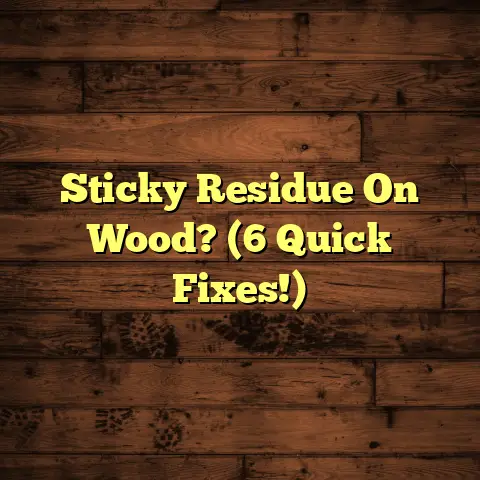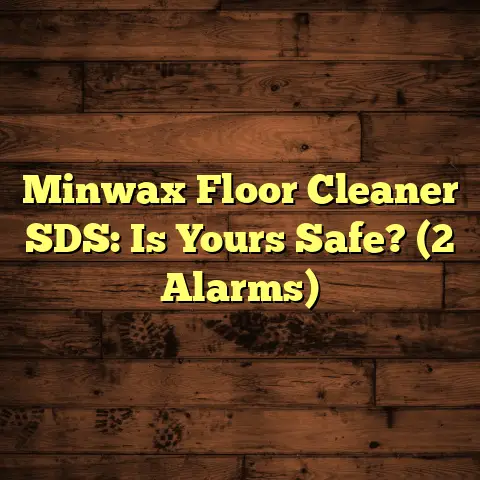Clorox Wipes On Floors? (3 Finish Destroyers!)
I’ve seen it all with floors – the good, the bad, and the downright ugly.
And believe me, I’ve seen some floors that have suffered at the hands of well-intentioned, but ultimately damaging, cleaning habits.
The Art of Craftsmanship in Flooring
Let’s talk craftsmanship.
Think about it: laying hardwood, installing intricate tile patterns, or even perfectly seaming vinyl – it’s all a skilled trade.
It’s about selecting the right materials, understanding design principles, and applying the perfect finish to protect and enhance the beauty of the floor.
These floors aren’t just surfaces we walk on; they’re investments, pieces of art that add value and character to our homes.
But here’s the thing: all that craftsmanship can be undone by improper care and cleaning.
And that brings me to the topic at hand: Clorox Wipes.
They’re convenient, I get it.
But are they really the best choice for your floors?
In my experience, often, the answer is a resounding NO.
Section 1: Understanding Clorox Wipes and Their Intended Use
So, what’s the deal with Clorox Wipes?
Let’s break it down.
1.1 Composition of Clorox Wipes
Ever wondered what’s actually in those wipes?
It’s not just water, that’s for sure.
Here’s a peek at some key ingredients:
- Water: The base, obviously, to dissolve and
carry the other ingredients. - Disinfectants (e.g., Alkyl dimethyl benzyl ammonium chloride):
The heavy hitters that kill bacteria and viruses. - Surfactants (e.g., Octyl decyl dimethyl ammonium chloride,
Dioctyl dimethyl ammonium chloride, Didecyl dimethyl ammonium chloride):
These help to lift dirt and grime from surfaces. - Chelating Agents (e.g., Citric Acid):
They bind to minerals in hard water,
making the cleaning solution more effective. - Solvents (e.g., Propylene Glycol):
Help to dissolve greasy stains. - Fragrances: For that “clean” smell.
The Environmental Protection Agency (EPA) provides
detailed information on the ingredients and their purpose
in disinfecting products like Clorox Wipes.
(Source: EPA Website on Disinfectants)
The disinfectants are great for killing germs, no doubt.
But those surfactants, chelating agents, and solvents?
They’re not always so friendly to floor finishes.
1.2 Targeted Surfaces and Applications
Clorox Wipes are designed for quick cleanups on hard, non-porous surfaces like:
- Countertops
- Sinks
- Bathroom fixtures
- Doorknobs
Think about it: these are areas where you want to quickly eliminate germs and bacteria.
The wipes are perfect for that.
But floors?
That’s a different story.
Floors, especially those with delicate finishes like hardwood or laminate, require a more nuanced approach.
The harsh chemicals in Clorox Wipes, combined with their potentially abrasive texture, can wreak havoc on your beautiful floors.
Section 2: The 3 Finish Destroyers of Clorox Wipes on Floors
Okay, let’s get down to the nitty-gritty.
Why are Clorox Wipes potentially bad news for your floors?
I’ve identified three main culprits:
2.1 Finish Destroyer #1: Chemical Composition
Remember those ingredients we talked about earlier?
Those disinfectants and solvents, while effective for killing germs, can be too harsh for many floor finishes.
Think about polyurethane, a common finish on hardwood floors.
Over time, repeated exposure to the chemicals in Clorox Wipes can break down the polyurethane, leading to a dull, cloudy appearance.
I’ve seen it happen countless times.
The floor starts to look lifeless, and no amount of polishing seems to bring back the original shine.
And it’s not just hardwood.
Laminate, vinyl, and even some tile floors can be affected by the chemicals in Clorox Wipes.
The chemicals can cause discoloration, etching, or even softening of the finish.
2.2 Finish Destroyer #2: Residue Build-Up
Here’s another sneaky problem with Clorox Wipes: residue.
Those wipes aren’t just cleaning; they’re also leaving behind a thin layer of cleaning solution.
Over time, this residue can build up, attracting dirt and grime like a magnet.
Suddenly, your “clean” floor looks even dirtier than before.
I’ve had clients tell me they feel like they’re constantly cleaning, but their floors never look truly clean.
That’s often a sign of residue build-up.
The residue can also make your floors feel sticky or slippery, which is definitely not what you want.
2.3 Finish Destroyer #3: Abrasive Texture
Have you ever really looked at the texture of a Clorox Wipe?
It’s not exactly smooth and soft, is it?
Those wipes have a slightly abrasive texture, which is great for scrubbing away tough grime on countertops.
But on floors, that abrasive texture can act like fine sandpaper, scratching and dulling the surface over time.
This is especially true for delicate finishes like high-gloss hardwood or polished tile.
Even if you don’t see the scratches immediately, they’ll eventually become visible, especially in high-traffic areas.
You’ll notice a general dullness and lack of shine, and your floors will start to look worn and tired.
Section 3: Case Studies and Real-World Examples
Alright, let’s get real.
I’m going to share some stories from my own experience of flooring nightmares caused by Clorox Wipes.
3.1 Case Study 1: Hardwood Floors
I had a client, let’s call her Sarah, who was meticulous about cleaning her hardwood floors.
She used Clorox Wipes religiously, thinking she was keeping them germ-free and sparkling clean.
But after a few months, she noticed something was wrong.
Her floors were losing their shine, and they looked dull and lifeless.
She called me in to take a look, and I immediately recognized the problem: finish damage caused by the chemicals in Clorox Wipes.
The polyurethane finish had started to break down, leaving the wood underneath exposed and vulnerable.
To fix the problem, we had to lightly sand the floors to remove the damaged finish and then apply several new coats of polyurethane.
It was a costly and time-consuming process, all because of a seemingly harmless cleaning habit.
3.2 Case Study 2: Laminate Flooring
Another client, Mark, had laminate flooring throughout his home.
He loved the low-maintenance aspect of laminate, and he thought Clorox Wipes were the perfect way to keep it clean.
However, he soon discovered that the wipes were leaving behind a sticky residue that attracted dirt and grime.
His floors always looked dirty, no matter how often he cleaned them.
When I inspected his floors, I found a thick layer of residue built up on the surface.
It was so bad that it was actually trapping dirt and making the floors look even worse.
We had to use a special cleaning solution to remove the residue, and then we recommended that Mark switch to a pH-neutral cleaner specifically designed for laminate floors.
3.3 Case Study 3: Tile and Grout
Even tile floors aren’t immune to the damaging effects of Clorox Wipes.
I had a client, Emily, who used Clorox Wipes on her tile floors, including the grout lines.
Over time, she noticed that the grout was starting to discolor and erode.
The chemicals in the wipes were breaking down the grout, making it more susceptible to staining and damage.
I had to re-grout several sections of her floor to restore its original appearance.
And I advised her to use a grout-specific cleaner to prevent future damage.
Section 4: The Impact of Poor Cleaning Choices on Floor Lifespan
So, what’s the big deal?
Why should you care about using the right cleaning products on your floors?
Well, it all comes down to longevity and cost.
4.1 Longevity of Flooring Materials
Proper cleaning and maintenance can significantly extend the lifespan of your floors.
According to the National Wood Flooring Association (NWFA),
a well-maintained hardwood floor can last for 100 years or more.
(Source: NWFA Website)
Laminate flooring can last for 10-20 years with proper care, while vinyl flooring can last for 15-20 years.
But those lifespans can be drastically reduced if you’re using the wrong cleaning products or methods.
Harsh chemicals, abrasive textures, and residue build-up can all contribute to premature wear and tear, forcing you to replace your floors sooner than you should have to.
4.2 Financial Implications
Replacing flooring is expensive.
According to HomeAdvisor, the average cost to install hardwood
flooring is between \$6 and \$12 per square foot.
(Source: HomeAdvisor Website)
Laminate flooring typically costs between \$2 and \$8 per square foot, while vinyl flooring costs between \$2 and \$5 per square foot.
So, if you have a 1,000-square-foot home, you could be looking at thousands of dollars to replace your floors.
And that doesn’t even include the cost of labor.
By using the right cleaning products and methods, you can avoid costly repairs and replacements down the road.
Investing in a good quality floor cleaner is a small price to pay for the peace of mind that comes with knowing you’re protecting your investment.
Conclusion: Preserving the Craftsmanship of Your Floors
Floors are more than just surfaces we walk on.
They’re an integral part of our homes, adding beauty, value, and character.
They’re also a testament to the craftsmanship of the people who designed, manufactured, and installed them.
By understanding the potential dangers of using products like Clorox Wipes on your floors, you can make informed choices that will protect your investment and preserve the beauty of your floors for years to come.
So, ditch the wipes and embrace a more floor-friendly cleaning routine.
Your floors will thank you for it!
Remember, a little knowledge goes a long way when it comes to floor care.
Choose wisely, clean gently, and enjoy your beautiful floors for years to come.





